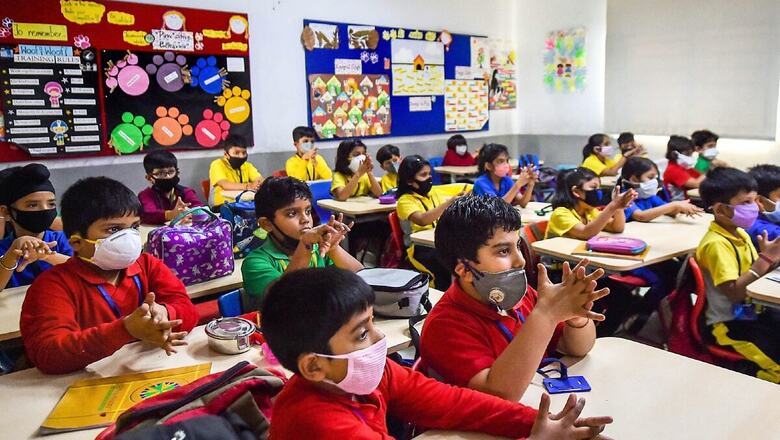
views
Initiating the education of students in preparatory and primary schools with mother tongue as medium of instruction has been projected as a big-ticket reform in the new National Education Policy 2020, forgetting the fact that earlier education policies of 1968 and 1986 did the same thing.
An overwhelming number of research studies in educational psychology make it almost consensual that one’s mother tongue should be a medium of instruction in early stages of schooling. Even Mahatma Gandhi realised this fact and wrote in Young India in 1921: “The process of displacing the vernacular has been one of the saddest chapters in the British connection. Ram Mohan Rai would have been a greater reformer, and Lokmanya Tilak would have been a greater scholar…if they had been brought up under a less unnatural system.”
Even Article 350A of our Constitution mandates the state governments and the local bodies to endeavour to provide education to linguistic minorities in their mother tongue.
Besides continuity, it makes the right noises about our linguistic complexities. Promoting multilingualism and power of language in teaching and learning is one of the fundamental principles of NEP.
Early Childhood Care and Education (ECCE) will be taken as an urgent national mission, in which the teaching of alphabet and languages in playful, inquisitive and activity-based ways forms a very important part of the curriculum to be developed by the NCERT. Starting from here up to class 5, the medium of instruction will be home language/mother tongue/local language/regional language.
This may be extended preferably till Grade 8 and beyond. But NEP itself makes it conditional by frequently using these two words – “wherever possible” and thus making this more pious in nature.
Here, there are four sets of languages in the pedagogical context and the policy document illustrates the differences and complexity by an example of a multilingual family. But their difference becomes starker and debilitating for the migrant labourers, who know the local language of their native places and are less exposed to Hindi, English or other regional languages.
So, the home language as a medium of instruction becomes more important in such a household. But it is very difficult to get lessons in the home language in places far off from their roots.
NEP recognises the problems of textbooks, especially high quality text books in science, and scarcity of language teachers. In the absence of textbooks, bilingual teaching will be encouraged.
There will be priority recruitment of local teachers to teach in local languages. Inter-state hiring of teachers in regional languages will be undertaken to implement three language formulas. The NEP also intends to conserve the endangered languages.
But, the approach of the ruling dispensation and resources allocated to the education make them more like a vision-statement and less-like concrete policy goals. Any policy is bound by its ecology. The demands of diversity become very daunting in the midst of preference of the ruling establishment for ‘One nation, one language’.
The NEP reposes more faith in techno-bureaucratic solutions in a centralised manner to resolve these challenges.
The version of nationalism espoused by BJP-RSS emphasises on Sanskrit-ised Hindi as a national language. So, even a project on different Indian languages has been conceived to find unity with a motto of ‘Ek Bharat, Shreshtha Bharat’.
Sanskrit is such a privileged classical language, which is considered to provide the matriarchal basis for India’s linguistic unity and hence, to be ‘mainstreamed with strong offerings in school’. Can such an overarching unitary edifice be conducive for teaching different subjects in different home languages, local languages and regional languages?
The experience of Maithili language in eastern part of the Hindi belt can tell us the story of high on symbolism and low on substance.
In 1830, Adam Wand, a British official of the Education Department, conducted a survey of schools in Tirhut region of then Bengal province. He found that Maithili was used as a medium of instruction in the schools of the north-eastern part of the district of Tirhut. When British education started unfolding in that region, Hindi got the preference and Maithili was classified as a dialect.
This relegated the language with rich history and literary tradition to a secondary position.
In 1949, Bihar government decided to use Maithili as a medium of instruction from classes 1 to 7. But this could not move beyond tokenism. Although some textbooks of different subjects in Maithili medium were printed in the early 1950s, they were not distributed in schools and discontinued after a year or two. The situation has not improved even a bit after its inclusion in the Eighth schedule in 2004 during the Atal Bihari Vajpayee regime.
Maithili is the only scheduled language which is languishing without textbooks written in its medium and without teachers discussing the lessons in this language.
In 2015, an organisation approached the Patna High Court with a plea to direct the state government to make arrangements for teaching-learning in Maithili language in Mithilaanchal region. And spending a few minutes on the website of Bihar Textbook Publishing Corporation (BTPC) will clearly show that nothing has changed on the ground. From classes 1 to 5, there is no Maithili medium text book of any subject listed there.
Likewise, there is no mention of school textbooks on the website of Maithili Academy of Bihar Government. Educational needs of linguistic minorities in different states and metros have not been dealt satisfactorily and this does not exude confidence. For instance, Bengaluru has around 30% Telugu-speaking population, but only a few Telugu-medium schools are available. Hiring the local language teachers out of their native state will be a cost-intensive and challenging task.
Taking shelter under the monolingualism of the ruling establishment at the Centre, the state governments will find it more convenient to ignore the demands of linguistic diversity.
While political preference is for unifying the diversities with increasing centralisation, the policy goals try to accommodate the reality of vast diversity of thousands of languages spoken and written in the country.
The increasing educational aspirations of millions of socially and economically weaker students will push the demand for mother tongue-based education further and bring face-to-face with monolithic nationalistic establishment. The test of NEP lies not in what it says, but to whom it says.




















Comments
0 comment